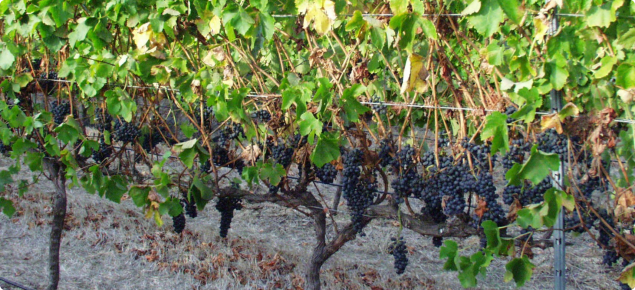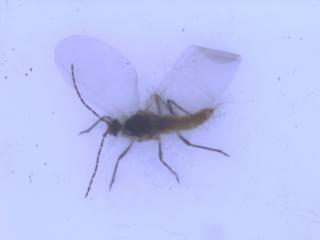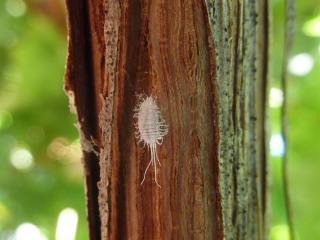
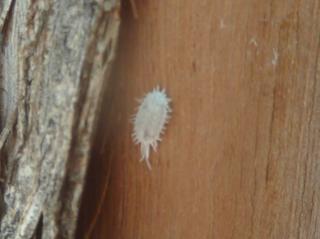
The longtailed mealybug Pseudococcus longispinus and obscure mealybug Pd. viburni are pests in grape and deciduous fruit tree crops in Western Australia. The origin of longtailed mealybug is thought to be eastern Australia, whilst the origin of obscure mealybug is not known.
Another mealybug species, citrophilus mealybug (Pd. calceolariae) occurs as a pest of grapevines in eastern Australia and is not known to occur in WA. This mealybug can be distinguished from other species by the red body contents when individuals are prodded compared with clear to yellow fluid for species that occur in WA. For more information refer to Citrophilus mealybug: declared pest.
In other countries, vine mealybug (Planococcus ficus) and grape mealybug (Pd. maritimus) are important mealybug pests in grapevines but have not been recorded in Australia.
While the appearance, damage and insecticides for the control of the two species are similar, their biology, habits and possibly natural control agents are sufficiently different to justify confirming their identification.
In Western Australia, because mealybugs prefer reasonably high humidity, they are not pests in inland drier areas. For example, they are not pests in the winegrape vineyards of the Frankland wine region, but are important pests in vineyards adjacent to the coast.
Description and life cycle stages
Adults
Mealybugs are oval, soft bodied insects covered in white powder like waxy material and the edge of the body bears a series of spines. There are four longer spines on the rear of the body - the central two of these are much longer than the insect body for longtailed mealybug but shorter than the body in obscure mealybug. Adult female mealybugs are 3-4mm long.
Mealybug adult males are frail, winged insects about half the length of adult females. They do not feed and live for less than a week. Because of their size they are rarely seen. Females of both species of mealybugs must mate to produce viable offspring. The females produce a pheromone to attract the winged males.
Immature stages
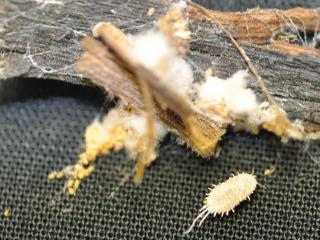
Obscure mealybug adults lay yellow to brown oval shaped eggs into an egg sac consisting of white fibrous material. The eggs hatch into the mobile crawler stage which disperse from the egg sac.
Longtailed mealybug adults produce live young in groups. These batches of crawlers remain under the female’s body for a short time before dispersing.
Crawlers are less than 1mm long. They seek a feeding site such as the underside of leaves, a grape bunch or the stem end of some fruits such as apples, plums and persimmons as well as the calyx end of fruit such as apples and pears.
Immature mealybugs that become adult females undergo three moults as they increase in size. Mealybugs that become adult males moult twice and then form a cocoon before the final moult to become a winged adult.
Seasonal patterns
In deciduous crops, mealybugs overwinter under bark. They may also be present on the root system, especially obscure mealybug.
Crawlers disperse from the overwintering sites to infest new growth in spring. In grapevines, foliage is infested whilst in deciduous fruit tree crops, the stem end of fruit may be infested quite early in the season - especially for apples where the stalk end of fruit is infested in preference to leaves.
As the insects develop and adults are formed and reproduce, the population increases and disperses. Mealybugs prefer more sheltered locations such as bunches in grapevines, the stalk end of apples, plums and persimmons, and the calyx end of apples and pears. Sometimes no mealybugs can be seen on leaves yet fruit is infested.
During the growing season, some mealybugs can be found under the bark of trunks and branches or cordons. From here they continue to produce crawlers to invade the canopy. It is likey these adults are feeding eventhough the substrate is woody.
After harvest, mealybugs in grapevines continue to breed on foliage up to leaf fall, which increases the infestation level of mealybugs on the wood ready to produce crawlers to invade the canopy next season.
In deciduous fruit tree crops where breeding on leaves is less common, the overwintering population is thought to consist of those insects that have left infested fruit to move to overwintering sites before harvest.
There may be up to five generations of mealybugs during the growing season.
Pest status
Mealybugs are pests in crops because of their presence, the unsightly black sooty mould produced by fungus that grows on honey dew - the sugary mealybug excretions – or the level of leaf loss associated with heavy infestation especially in vineyards.
They are also vectors for virus diseases in vineyards.
Direct damage
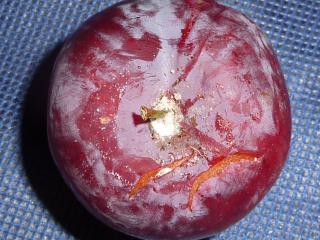
Mealybugs feed on the sap of plants and excrete excess fluid as honey dew. When present in large numbers, the honey dew supports the growth of sooty mould. Both the presence of mealybugs and sooty mould can lead to cosmetic damage resulting in rejection of fruit at market - table grapes, apples, plums, pears and persimmons.
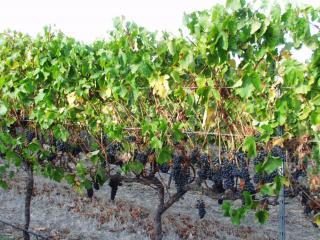
In winegrape vineyards, leaf loss associated with heavy infestations of mealybugs exposes fruit to sunburn, The canopy of late maturing red varieties may be so depleted that fruit cannot be ripened sufficiently. Fruit that is heavily infested with mealybugs and has excessive sooty mould is rejected by wine makers.
Virus transmission
As sap suckers, mealybugs are capable of acquiring and transmitting virus diseases such as leafroll virus in grapevines.
To limit virus infection in vineyards, material should be tested for virus (especially grapevine leafroll associated virus 1 and 3 - GLRaV-1 and GLRaV-3) prior to planting or obtained from a reliable source such as the Western Australian Vine Improvement Association.
If virus is present within a vineyard block, the rate of transmission of the virus across a block can be restricted by controlling mealybugs present there.
When high virus levels occur across a block such that yield declines resulting in the block being uneconomic, the only control option is to remove the vines and replant the block after a suitable ley period to ensure no live vines or mealybugs remain.
Monitoring
Regions and crops with a history of mealybug infestation can avoid problems by monitoring to determine whether action is required, and the timing of such action to protect crops.
After an infestation of fruit is noticed during the growing season, the likelihood of a problem the following season can be assessed by checking under the bark of plants across the infested area during winter.

Overwintering mealybugs under bark leave behind white fibrous material, which can remain for over a year. Careful examination of the white residue with a ten times hand lens is required to confirm whether live mealybugs are present. To cover a reasonable area of orchard or vineyard, examine a plant for a set time such as two minutes to determine whether it is infested or not, then move to the next plant. Checking 25 plants across an infested area is a good way of assessing the proportion of plants infested with live mealybugs, and to determine if a problem will occur in the coming season. Further monitoring and possible action is suggested if more than 5% of plants are infested. For levels of 10% and above, inundative releases of commercially available predators or systemic insecticide should be considered.
When plants recommence growth in spring, check the underside of leaves in vineyards and in deciduous fruit tree crops check both the stem and stalk end of fruit to determine whether control action is required. At least fortnightly checking of 25 leaves or fruitlets/bunches across infested blocks will ensure both the abundance and timing of arrival of mealybugs is assessed to assist with making decisions on mealybug control.
Depending on the history and importance of mealybugs in a crop, an action theshhold of 5% plants infested may be appropriate. An increasing proportion of leaves or fruit infested over successive monitoring occasions is also a sign that action needs to be taken.
After harvest, mealybugs may continue to breed within crops. It is not clear whether controlling these populations helps with pest management the following season, but in table grapes up to two more generations of mealybugs can occur before crop senescence. If no control action is taken, it is likely the overwintering population of the pest will be much higher leading to a greater pest pressure the following season. This will increase the challenge for successful crop protection.

Synthetic pheromones for both species of mealybug have been identified and have been used for research to monitor the seasonal abundance of adult male mealybugs. For both species, male mealybugs were most abundant in late summer to early winter. Whether deploying pheromone traps as a monitoring tool to warn of potential pest populations of mealybugs is worthwhile is compromised because the lures are not easily obtained, confirming the small males on traps requires a microscope and the abundance of males does not readily indicate the presence of crawlers on crops because of the seasonality of males. More research is required to clarify whether deploying pheromone traps can help with mealybug monitoring.
Control
Cultural
Mealybug infestations of are most likely to commence when infested planting material is used. Ensuring plants are free of these insects or treating young plants to try to eliminate an infestation in the early stages of establishing a block will help with later pest management.
Because only male mealybugs can fly, this pest relies on mechanical transport to infest new areas. Cleaning machinery and farm items such as bins that may contain infested leaves or fruit residue brought onto a property and ensuring workers have not come from mealybug infested farms will help prevent the introduction of mealybugs.
Mealybugs prefer high humidity. If leaf plucking or summer pruning is an option for a susceptible crop, taking such action during the growing season will not only help create an undesirable environment but also open canopies to improve spray coverage if pesticides are used. Depending on the timing of leaf plucking, this may remove mealybugs that infested the canopy earlier, and help with reducing pest numbers.
In mealybug infested vineyards, bunches touching the cordon, crown or trunk are most likely to become infested because crawlers disperse from under the bark. If bunch thinning is a management practice, select bunches touching the cordon, crown or trunk for removal.
Ants have been claimed to assist mealybug infestations because they are attracted to the excretions of honey dew. It is more likely they occur together with mealybugs after an infestation is well established. Heavy infestations of mealybugs are not always associated with attendant ants.
Biological
Predators



Two species of predators are available from commercial rearing facilities for release into infested crops. They are the mealybug destroyer (Cryptolaemus montrouzieri) and green lacewing (Mallada signata). These predators are most applicable for use in winegrape vineyards where low numbers of mealybugs can be tolerated. In fresh fruit crops where cosmetic appearance is important, they are unlikely to reduce populations to acceptable levels, but may contribute to other control methods. The producers of these agents will be able to recommend whether their use is worthwhile for a particular situation, and the details of releases such as rate and number and timing of releases.
As well as the two species of predators available commercially, a range of naturally occurring predators are present in Western Australia. They include larvae of predatory flies and brown lacewing. They are most abundant near the end of the growing season when pesticide use has declined and mealybug numbers are likely to be high. The effect of such predators is considered to be minor.
Parasites

There are some species of wasps that occur naturally in Western Australia and attack mealybugs. They are most abundant after harvest and are thought to have a minor impact only on numbers of mealybugs. The identity of parasites that occur in WA is not known. With more knowledge on parasites that occur in WA, there may be opportunities to introduce species of parasites reported from mealybugs in eastern Australia.
Chemical
For other species of mealybug, the synthetic pheromones developed have been used in pest management as a means of disrupting mating. While synthetic pheromones are available for both longtailed mealybug and obscure mealybug, they have not been progressed into suitable products for the same management method.
General information on registered insecticides for control of mealybugs on any crop is available from the InfoPest website and from the Australian Pesticides and Veterinary Medicines Authority.
Grapevines
Information on insecticides registered for use against mealybugs on both table and wine-grapes is available from the Department of Primary Industries and Regional Development, Agriculture and Food Section, Western Australia Viticulture Spray Guide. Specific information for winegrapes is available from the Australian Wine Research Institute Dog Book.
Deciduous fruit tree crops
Information on insecticides registered for use against mealybugs on deciduous fruit tree crops is available from the Department of Agriculture and Food, Western Australia Pome and Summerfruit Orchard Spray Guide.

